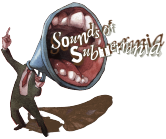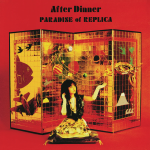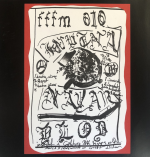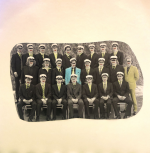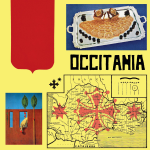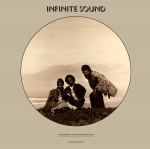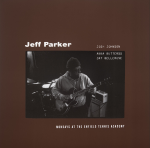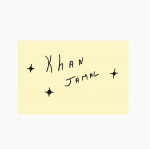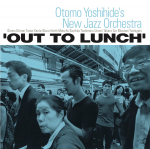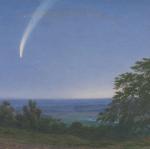Labels
Aguirre
- 01. Paradise Of Replica
02. A Walnut
03. Kitchen Life I
04. Motorcycle
05. Kitchen Life II
06. Ironclad Mermaid
07. Dancing Twins
08. KA-NO-PU-SU-NO-HA-KO
09. I'll Just Go BirdwatchingAFTER DINNER
Paradise Of Replica
[engl] After Dinner’s Paradise of Replica is a concise nugget of tomfoolery that occupies a whimsical no man’s land between art pop, Japanese folk music and full-assed Art Zoydian avant proggery. Gentle, arcane and covertly sweeping, it typifies that friendly strain of experimentalism that Eastern music seems so predisposed towards and which curious minds find such great delight in. Assembled by the enigmatic chanteuse and composer known simply as Haco, After Dinner was less a band and more of a loose art collective that utilized a plurality of different musical disciplines stapled together through free improvisation sessions. And some of this does come through on Paradise of Replica—the record is a scrapbook of bells, strings and koto humming under Haco’s ethereal vocals, and the effect, while perfectly tuneful, does come off more as a musical project than a conventional album. But Paradise of Replica is far from an impenetrable scholastic endeavor—in fact, there’s something of an Elephant 6-like quality in its ability to warp conventions while still coming off more or less like pop music. Counter to the ramshackle hostility of much improvised music, After Dinner’s choices are melodious and feel deliberately sequenced. Even crescendos don’t tend to rise above a murmur, and there are even apparent hooks on tracks like “A Walnut” and “Ironclad Mermaid.” Ultimately, there’s not much to be said about Paradise of Replica that can elucidate more than actually hearing it will be able to. Proggy, playful and lush, it’s a brief glimpse into something in the vicinity of genius, and just outside the realm of commercial music. It’s a quietly bold project that shows a softer side of the avant-garde, and makes a perfect companion to Stereolab and Magma at once.- Format
- LP lim
- Release-Datum
- 03.09.2022
- 01. Knutna Nävar
02. Arvet
03. Knutna Nävar - Repris
04. Lär Av Historien
05. Inmarsch
06. Leendet Från Helvetet
07. UtmarschBLOD
Knutna Nävar
[engl] Swedish progg is not to be confused with "prog" as in progressive rock music. When we are talking about progg, we are refering to the Swedish music movement influenced by the political climate of the late 60's, to some extent the hippie movement and in many cases also Swedish folk music. Music highly driven by an political agenda. Blod's Knutna Nävar, originally released in an edition of 150 copies on Förlag För Fri Musik in 2018 and later a small cassette run, is pretty much a lost progg classic from the 70's. This is not a case of copying a certain sound though, far from it, neither are ideas really rehashed nor does the album feel nostalgic in that sense. Rather it feels like if someone has read about the progg movement and all the records but never actually heard it, yet decided to do an album and somehow managed to succeed big time. Further developing the sound palette and ambience initiated with parts of the Leendet Från Helvetet recording, the music feels slightly louder and more in your face. It's like it's more of everything. The melodies are immediate and it's quite impossible to resist the brash catchiness of it all. Albeit mentioning progg music and it's importance for this recording, the actual musical side of Knutna Nävar has in reality more in common with soundtrack/library music and Swedish composers like the late Björn Isfält when you attempt to break it down. The crude DIY approach and anything-goes mentality just adds an extra dimension to it all and ultimately places the music somewhere else. There's a rather blunt use of samples throughout the record (sources probably best to leave out, though you don't have to be a Einstein to figure these out), but then again this is made by the same guy that gave the world the ABBA album. Those samples have managed to become an integral part of the music through the few years that has passed and though well familiar with the records those snippets are now to me genuinely Blod and nothing else. It seems like everyone has their own favourite but Knutna Nävar is the Blod album I have returned to the most. It has that extra something that sets it apart and if I would have to pick up a few records that sums up why Gothenburg has been a pretty damn awesome place to be in the last 10 years or so, this would definitely be one of the top picks.- Format
- LP lim
- Release-Datum
- 17.06.2022
- 01. Håll Dem Borta
02. Natten
03. Leendet Från Helvetet
04. Leendet Från Helvetet - repris
05. Lust
06. Satan
07. Tro, Hopp & Kärlek
08. Tro, Hopp & Kärlek/ Lust - reprisBLOD
Leendet Från Helvetet
[engl] It's been a true pleasure but also a rather chaotic experience to follow the progress of Blod from a close distance since the beginning. I have fond memories of receiving the odd cassettes from the early days, like the severely fucked up Unga Röster (later issued as an LP on Förlag För Fri Musik) and the awfully mesmerising Prat Om Depression recording. Returning to Leendet Från Helvetet for the first time for long a while, it's quite evident that the album marked a new phase in the troubled Blod universe. There's few traces left of the found tapes/audial voyeurism and brutish stop/rec editing that made up the first few releases, instead we are served with what is pretty much a proper album in a, sort of, traditional sense. The record opens with a sole beat from a hand drum soon accompanied by a beautiful and very Blod-ish subtle melody from a glockenspiel but it only takes a few minutes before Gustaf's past as a free jazz aficionado is noticeable with the rather rough saxophone burst of 'Natten'. It's not until the title track that things kicks off for real though, most likely the first example of the sound and, maybe more so, very special feeling that I would say most people associate Blod with nowadays. To me, it's the sound of growing up in Sweden in the 80's; having two channels on the TV, eating brown food, rainy summers, taping commercial stuff on the radio, playing D&D in a purple tent in the garden. Memories of that certain bright light that can occur during the Scandinavian summers, those warm days when the skies are foggy. Long windswept grass and a very peculiar feeling of utter boredom. Arguably, Blod has never sounded more Blod than on this track, this is the very essence of the man's work right here. The progamm continues on side B with the solemn piano piece 'Lust', another saxophone rager and then the flipside's centrepiece 'Tro, Hopp & Kärlek' which pretty much mirrors the title track in it's larger-than-life scope and pure beauty. A couple of years has passed since it's initial release back in 2017 and I think it's safe to say that Leendet Från Helvetet is by far the most overlooked album in the Blod discography (well, if you can say that about a record that was only pressed in a mere 100 copies to begin with!). The blueprint to what would later evolve into the bombastic Knuta Nävar, the intimate Tusen Bitar, the highly confusing medieval masterpiece Missväxt, not to mention all the self-released cassettes and CD-rs.- Format
- LP lim
- Release-Datum
- 17.06.2022
- 01. 2019-07-08 I
02. 2019-07-08 II
03. 2019-05-19
04. 2021-04-28FRANCE
Occitanie
[engl] France is the trio of Jeremie Sauvage on electric bass, Mathieu Tilly on drums and Yann Gourdon on amplified hurdy-gurdy. They play one note / one rhythm producing energetic performances reminiscent of the early collaborations between Faust and Tony Conrad. Creativly recycled influences result in intense shows with pounding overtones and repetitive pulsing rhythms. Loud straight and trance-inducing. The pertinency of the recordings only slowly appear On “Occitanie" in the mass of sound, the rhythmic repetition and the elongated drones. The hurdy-gurdy forces you deeper, highlighting points of microtonal flux, cracking open the single note, the nodding rhythm, to imply the presence of every note, every sound, inside it. The insensible evolution, lurks in a corner of noise and finally imposes itself slowly on careful listening. The band members of France perform in various other projects: Tanz Mein Herz, Toad and Jérico, all are member of the collective La Novià, an organisation based in Haute-Loire which brings together professional musicians and is a place for reflection and experimentation around traditional and / or experimental music. In 2009, France was invited to play in Pau, a city far south-west of France, next to spain, by the people running Pagans Musica, a like-minded traditionnal-oriented group of people, also bent on educational issues concerning the local music and dialect: Occitan and on fusioning traditional musics and rock related sounds and instruments. They had set up a show for France and their band Artus and originaly wanted to have Acid Mother's Temple join the bill. The japanese band had done versions of songs coming from their village (eg. "La Nòvia") but weren't touring near France so instead they invited Duo Ancelin Rouzier as the third act, a band both Artus and France were also very fond of. Pagans had everything set-up for the concert to be recorded and as France had plenty of time for sound-check, they went on to record the “Pau" album in the afternoon, taking a thirty seconds pause in the middle of the session so as to mark both sides of the vinyl. The Occitanie Lp is the recording of the live set later that night, with no cut and a longer, more savage performance.- Format
- LP lim
- Release-Datum
- 17.06.2022
- 01. Do It All
02. Stagflation
03. The Ocean Moves Primitively
04. Spanish Tale
05. Synthetic Variation
06. Homeland Rhythm CyclesINFINITE SOUND
Contemporary African-Amerikan Music
[engl] Conscious avant-garde free jazz featuring Roland P. Young originally released in 1975 on the eclectical 1750 Arch records. “1750 Arch was a beautiful Spanish-style hacienda,”recalls composer and multi-instrumentalist Roland P. Young. “It had a wonderful recording studio in the basement and the salon was converted into an intimate performance setting.” Young played solo gigs at that venue, in Berkeley, California, and also performed there in a duo with cellist Chris Chaffe. He remembers it as a particularly “transcendent” setting for concerts by Infinite Sound, his trio with singer Aisha Kahlil and bassist Glenn Howell. Infinite Sound’s Contemporary African-Amerikan Music appeared in the uniquely diverse 1750 Arch catalogue in 1975. For Roland Young such a context was not incongruous. Contemporary African-Amerikan Music is a title that positioned the record quite specifically in 1975. But Young shares Buckner’s distaste for labels that fix expectations too rigidly and close down creative possibilities. Culturally and politically the early 70s appeared to Young to be a time of change and spiritual renewal. “There was a vibe in the air that we connected with, along with other kindred spirits world-wide. What appeared to be ‘experimental’ was reaching for sounds and emotions that were unfamiliar. We often performed at rallies in support of various causes: Black Liberation, Women’s Movement, Anti-War Movement, Gay Liberation. While the music came out of the Black Liberation struggle our ultimate goal was a blending of cultures.” In 1968 Young was working as a DJ at KSAN, an underground rock station in San Francisco. “Glenn Howell used to call me when I was on air to comment about the music I was playing. He told me he was a musician and I invited him to come down to the station. We started to talk about music, then decided to get together and play. Young and Howell met Aisha Kahlil at one of their concerts. “A mutual friend introduced her and told us she was a good vocalist, loved our music and wanted to sing with us. We invited her to a rehearsal and soon after we invited her to join the group. Infinite Sound came together very easily and had a natural feel. We definitely had a shared intuition, and we created a lot of music. Each of us would bring ideas to rehearsals and we would work on them. Glenn tended to bring jazz tunes, Aisha tended to bring African-influenced compositions and I brought world, electronic, classical, jazz and avant garde material. Occasionally we would rearrange standards by composers like Duke Ellington and Charles Mingus. We talked a lot about how to present our material and how compositions would flow, one to the other. We were also conscious of how we dressed for performances, how we moved on stage, how we interacted with each other and the audience. We wanted it to be a ‘happening’. On occasion we would invite dancers to perform with us, friends of Aisha.” Contemporary African-Amerikan Music preserves a fascinating glimpse of the trio in action. It testifies to the energy that Infinite Sound channelled into their music, but also to their imaginative breadth and expressive versatility.Their compositions embrace mobile forms, with Howell’s buoyantly springy and resilient bass taking on a strong pivotal role around which Young’s horns and Kahlil’s voice dance and spar and soar and play. Well-defined rhythms dissolve into textures; melodic shapes soften into shadings of timbre or flare into exuberant bursts of tonal colour. The music’s mood swings unpredictably from flamboyance to introspection; pacing shifts spontaneously from languor to urgency. Moments of musical allusiveness, sly quotation or stylistic reference, mutate into passages of wild inventiveness. Tantalisingly this stimulating and varied set of pieces was this trio’s only release. Times have changed, yet increasingly in recent years creative artists have come to accept the need to erase musical boundaries and erode the constraints of aesthetic categorisation. Infinite Sound, and their enlightened host Tom Buckner, were decidedly ahead of the game.- Format
- LP lim
- Release-Datum
- 22.01.2021
- 01. 2019-07-08 I
02. 2019-07-08 II
03. 2019-05-19
04. 2021-04-28JEFF PARKER
Mondays at The Enfield Tennis Academy
[engl] Mondays at The Enfield Tennis Academy, x2 LPs of long-form, lyrical, groove-based free improv by acclaimed guitarist & composer Jeff Parker's ETA IVtet. Recorded live at ETA (referencing David Foster Wallace), a bar in LA’s Highland Park neighborhood with just enough space in the back for Parker, drummer Jay Bellerose, bassist Anna Butterss, & alto saxophonist Josh Johnson to convene in extraordinarily depth-full & exploratory music making. Gleaned for the stoniest side-length cuts from 10+ hours of vivid two-track recordings made between 2019 & 2021 by Bryce Gonzales, Mondays at The Enfield Tennis Academy is a darkly glowing séance of an album, brimming over with the hypnotic, the melodic, & patience & grace in its own beautiful strangeness. Room-tone, electric fields, environment, ceiling echo, live recording, Mondays, Los Angeles. Jeff Parker's first double album & first live album, Mondays at The Enfield Tennis Academy belongs in the lineage of such canonical live double albums recorded on the West Coast as Lee Morgan’s Live at the Lighthouse, Miles Davis' In Person Friday & Saturday Night at the Blackhawk, San Francisco & Black Beauty, & John Coltrane's Live in Seattle. While the IVtet sometimes plays standards &, including on this recording, original compositions, it is as previously stated largely a free improv group —just not in the genre meaning of the term. The music is more free composition than free improvisation, more blending than discordant. It’s tensile, yet spacious & relaxed. Clearly all four musicians have spent significant time in the planetary system known as jazz, but relationships to other musics, across many scenes & eras —dub & Dilla, primary source psychedelia, ambient & drone— suffuse the proceedings. Listening to playbacks Parker remarked, humorously & not, “we sound like the Byrds” (to certain ears, the Clarence White-era Byrds, who really stretched it). A fundamental of all great ensembles, whether basketball teams or bands, is the ability of each member to move fluidly & fluently in & out of lead & supportive roles. Building on the communicative pathways they’ve established in Parker’s -The New Breed- project, Parker & Johnson maintain a constant dialogue of lead & support. Their sampled & looped phrases move continuously thru the music, layered & alive, adding depth & texture & pattern, evoking birds in formation, sea creatures drifting below the photic zone. Or, the two musicians simulate those processes by entwining their terse, clear-lined playing in real-time. The stop/start flow of Bellerose, too, simulates the sampler, recalling drum parts in Parker’s beat-driven projects. Mostly Bellerose's animated phraseologies deliver the inimitable instantaneous feel of live creative drumming. The range of tonal colors he conjures from his extremely vintage battery of drums & shakers —as distinctive a sonic signature as we have in contemporary acoustic drumming— bring almost folkloric qualities to the aesthetic currency of the IVtet's language. A wonderful revelation in this band is the playing of Anna Butterss. The strength, judiciousness & humility with which she navigates the bass position both ground & lift upward the egalitarian group sound. As the IVtet's grooves flow & clip, loop & repeat, the ensemble elements reconfigure, a terrarium of musical cultivation growing under controlled variables, a tight experiment of harmony & intuition, deep focus & freedom. For all its varied sonic personality, Mondays at The Enfield Tennis Academy scans immediately & unmistakably as music coming from Jeff Parker‘s unique sound world. Generous in spirit, trenchant & disciplined in execution, Parker’s music has an earned respect for itself & for its place in history that transmutes through the musical event into the listener. Many moods & shapes of heart & mind will find utility & hope in a music that combines the autonomy & the community we collectively long to see take hold in our world, in substance & in staying power. On the personal tip, this was always my favorite gig to hit, a lifeline of the eremite records Santa Barbara years. Mondays southbound on the 101, driving away from tasks & screens & illness, an hour later ordering a double tequila neat at the bar with the band three feet away, knowing i was in good hands, knowing it would be back around on another Monday. To encounter life at scales beyond the human body is the collective dance of music & the beholding of its beauty, together. —Michael Ehlers & Zac Brenner- Format
- DoLP
- Release-Datum
- 28.10.2022
- 01. Cosmic Echoes
02. Drum Dance
03. Inner Peace
04. Breath of LifeKHAN JAMAL`S CREATIVE ARTS ENSEMBLE
Drum Dance To The Motherland
[engl] There’s not another album on the planet that sounds even remotely like vibraphonist Khan Jamal’s eccentric, one-of-a-kind masterpiece, Drum Dance To The Motherland. Thirty years after its release, the album’s tapestry of sound, fearless abstractions, relentless grooves, cool swing, flashes of ecstasy, & pan cultural embrace remain powerful & beyond category. One of only three albums released on the Philadelphia-based Dogtown label, it was barely distributed beyond the city’s limits when it came out in the early ‘70s. Finally available again, a really stunning document of musical exploration, a classic session. In its improbable fusion of free jazz expressionism, black psychedelia, & full-on dub production techniques, Drum Dance remains a bracingly powerful outsider statement fifty years after it was recorded live at the Catacombs Club in Philadelphia, 1972. Comparisons to Sun Ra, King Tubby, Phil Cohran & BYG/Actuel merely hint at the cosmic otherness conjured by The Khan Jamal Creative Arts Ensemble & by sound engineer Mario Falana's real-time enhancements. Clearly, the members of the Khan Jamal Creative Arts Ensemble saw African American music as a continuum that stretched from the Motherland through the blues, R&B, jazz, & free jazz, & they prided themselves on mastering the continuum. In the early ‘70s, these were fairly new ideas, but they had taken firm root in Philadelphia. The search for an African American music that is modern & culturally progressive but rooted in an African tradition is the music’s heart & soul. Its connection to the specific African American community in Philadelphia is its immediate inspiration. “My ancestors eventually show up in my music every time i play,” Jamal says. “I’ve always said that my backyard is Africa.” Originally issued by Jamal in 1973 in an edition of three hundred copies on ‘Dogtown’ records, Drum Dance To The Motherland was effectively a myth until eremite’s 2005 CD reissue. With the master tapes long vanished, the audio was transferred at Sony Music's 54th street studio from a minty copy of the original LP. Includes an insert with Ed Hazell's detailed telling of Drum Dance's incredible history. Under License From Eremite Records.- Format
- LP lim
- Release-Datum
- 17.06.2022
- 01. Hat And Beard
02. Something Sweet, Something Tender
03. Gazzelloni
04. Out To Lunch
05. Straight Up And Down - Will Be Back Part I
06. Straight Up And Down - Will Be Back Part IIOTOMO YOSHIHIDE`S NEW JAZZ ORCHESTRA
Out To Lunch
[engl] First-time vinyl release. Old-style gatefold LP with liner notes by Kahimi Karie, Otomo Yoshihide & Tonoyama Taiji. Eric Dolphy's final studio album is hailed as one of the finest examples of mid-'60s post bop. Its reputation is purely one of backwards significance. Dolphy, having recorded the album in February 1964, was in Europe less than six weeks later and his all-too-brief life ended less than two months after that. Though likely he never held a copy in his hands or heard any critical opinion of it, it marked his last flurry of original compositions and is considered his apex. It is fascinating to consider whether he would had moved past or away from the album in 1965, had he lived. Though Dolphy should not be considered an avant-garde musician by the term's most common definitions, most interpretations of Out To Lunch have been done by players working squarely in that area. So it is with this album, the most ambitious in its recreation of the five-tune disc (with one original added to the final "Straight Up and Down, extending the piece to almost thirty minutes). All five compositions from the original quintet LP are revisited in the same order, the record sleeve even duplicates the old album jacket, down to the typeface and black-and-blue color scheme, although a photo taken by Daid? Moriyama inside Tokyo's massive (and massively busy) Shinjuku railway station replaces the Dolphy's album's enigmatic "Will Be Back" sign, whose clock hands indicated no conventional time of expected return. Otomo Yoshihide first came to international prominence in the 1990s as the leader of the experimental rock group Ground Zero, and has since worked in a variety of contexts, ranging from free improvisation to noise, jazz, avant-garde and contemporary classical. The always surprising and sometimes confounding turntablist, sound artist, onkyo improviser and now avant jazzer heading up a 15-piece aggregation of Japanese and European experimentalists. Who better to grapple with Dolphy's legacy -- so idiosyncratic in its day and yet so influential to creative improvisers who followed -- than a musician with his own singular take on how sounds can be organized in the jazz realm over 40 years later and half a world away? In other words don't expect the conventional from Otomo any more than you would from Dolphy himself. That's not to say that recognizable themes ("Hat and Beard," "Out to Lunch," "Straight Up and Down") don't appear, or that individual players -- including Alfred Harth on bass clarinet bursting into the mix and leaping across the instrument's tonal range in a way that recalls the master himself -- don't carry forward echoes from the past in the spirit of a sincere and heartfelt homage. However, a good deal of the time all bets are off; in addition to the usual brass, reeds, bass, and drums (and of course a bit of vibraphone, here played by Takara Kumiko in far less prominent role than that of Bobby Hutcherson) are such sonic paraphernalia as sine waves, contact mike, no-input mixing board, and, of course, "computer." (Otomo himself plays skronky electric guitar.) From composition to composition and even during episodes within compositions, the band takes radically different approaches. There are blasts of free jazz energy not too far removed from the Peter Brötzmann Tentet, an impression reinforced by the presence of spluttering wildman Mats Gustafsson on baritone sax. Not surprisingly and often in contrast with the Dolphy original, the music is dense and filled to overflowing with sounds -- sometimes due to fundamental reworkings in structure rather than just the larger size of the ensemble. The middle section of "Something Sweet, Something Tender" somewhat belies the original's title with elongated howls and cries from the horns over slo-mo bass, drums, and electronic noise poised somewhere between dirge and drone, and the sudden explosion of punk-ish rock energy in the following "Gazzelloni" is a startling contrast. At times, the feeling is that of listening to the original Out To Lunch while a séance is going on to contact Dolphy's ghost, with supernatural sounds swirling around the stereo. The effect is disconcerting, as is the post-apocalyptic cloud hanging over the arrangements, but it makes the effort more than an unnecessary tribute album. Instead, Dolphy is transported into the 21st Century and allowed to romp through modern developments in music. An inspiring concept and an album that will stretch the boundaries of anyone who comes into contact with it.- Format
- DoLP
- Release-Datum
- 03.09.2022
- 01. Temidden Laaghangende Wolken
02. Inkohiering
03. Vlucht Met De Ladder
04. Eiland Zonder Oceaan
05. 60 Manen
06. KlauwzeerTHE BEGOTTEN
Temidden Laaghangende Wolken
[engl] The Begotten is the brainchild of Jürgen De Blonde (Köhn/de portables) and Brecht Ameel (Razen), who initially performed a number of shows and released a CS under the moniker 'Kohier' - gleefully referencing the absurdity of Belgian tax systems and institutions. On their debut LP "Temidden Laaghangende Wolken" they are joined by percussionist and improv-veteran Dirk Wachtelaer (Pablo's Eye/Vanishing Pictures), who locked with De Blonde and Ameel's post-reality continuum during a recording session at Les Ateliers Claus in Brussels. In this new trio format, The Begotten weaves a stripped-down set of after-hours, trancey observations on keys, baritone guitar and drums. Neon-lit bars are named Le Kheops or 60 Moons, streets are soaked in sheets of rain, people are staring at tax sheets and comets pass by unnoticed. Dub with tears; "Temidden Laaghangende Wolken" is the perfect backdrop of a strongly medicated game of Manillen during a 'Derrick' rerun. Edition of 250- Format
- LP lim
- Release-Datum
- 22.01.2021
